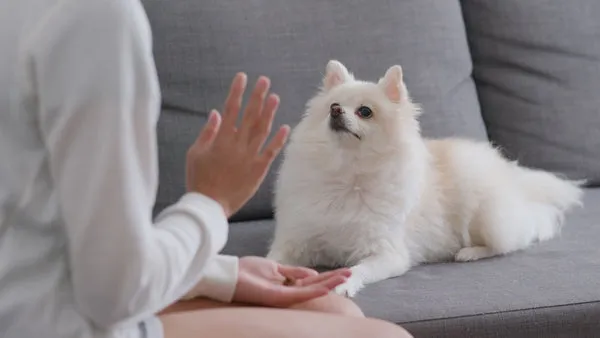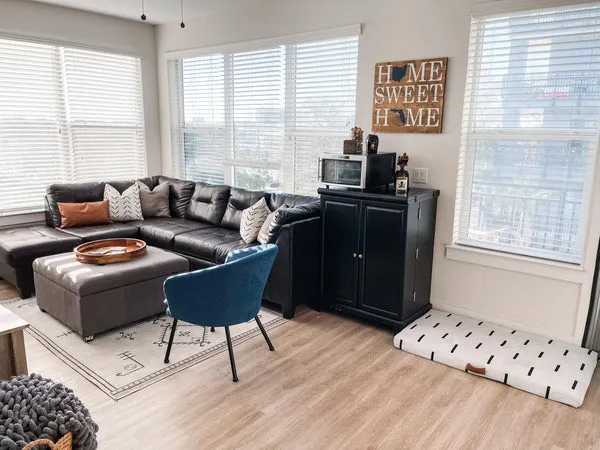It’s a common scenario: you’ve invested in beautiful furniture, only to find your beloved canine companion claiming it as their own. Whether it’s a playful puppy or an older dog with established habits, teaching your dog to stay off the furniture can feel like an uphill battle. However, establishing clear boundaries for couch time is a significant part of responsible dog ownership and, thankfully, a reasonably straightforward training process that often yields results in just 2 to 4 days with consistent effort.
At Dog Care Story, we understand the desire for a harmonious home where both humans and pets thrive. This guide will walk you through the most effective and humane methods to train your dog to stay off the furniture – for good this time. Remember, the principle that you can teach an old dog new tricks holds true for furniture training too!
1. The Block Method: Physical Barriers for Success
This method offers a direct and often immediate solution by physically preventing your dog from accessing the furniture. It’s particularly useful for dogs who already have a habit of jumping on couches. When you’re at home, simply occupying the available space on the sofa can be enough. If there’s no room for your pup to jump onto, they won’t feel the need to try.
For times when you can’t actively block the space or when you’re not home, creative use of physical barriers is highly effective. Consider employing baby gates, strategically placed large objects, or even stacks of pillows. Many stylish baby gates or decorative dividers are available that won’t disrupt your home’s aesthetic. Another practical option is to temporarily move ottomans or chairs to block off the section of the living room containing the furniture you want to protect. This creates a clear boundary that your dog can understand.
 Decorative pet gate blocking couch access
Decorative pet gate blocking couch access
2. Mastering the “Off” and “Up” Commands
While the block method is a practical preventative measure, it doesn’t fully replace direct training. Teaching your dog specific commands is crucial for long-term success. The “off” command is fundamental for teaching your dog to dismount furniture, while the “up” command can be introduced if you wish to allow your dog on the furniture only when invited.
To teach the “off” command, sit in your living room and observe your dog. The moment they hop onto the forbidden furniture, calmly approach them with a high-value treat or their favorite toy. Clearly say “off” as you lure them off the furniture and onto the floor. Reward them immediately once all four paws are on the ground. Repeat this process consistently. Each time your dog gets on the furniture, use the “off” command and reward their compliance. With enough repetition, your dog will associate the word “off” with leaving the furniture and receiving a reward.
For those who prefer a more flexible approach, teaching the “up” command allows your dog to join you on the couch under specific conditions. You can designate a special blanket or even a removable bed cover (like our LAY LO covers) for them to lie on when invited. To teach “up,” gently pat the designated spot on the couch, excitedly say “up,” and wiggle a treat or toy to encourage them to jump. If they hesitate, a gentle upward pull on a leash can guide them. As soon as they reach the spot, praise them enthusiastically and offer a reward. This teaches them that furniture access is granted only with your explicit invitation. Practice both “up” and “off” commands so your dog learns the clear distinction between permitted and forbidden access. This controlled interaction also reinforces good leash guidance skills.
 Dog sitting on floor beside couch, away from furniture
Dog sitting on floor beside couch, away from furniture
3. The “Place” Command: Offering an Alternative
One of the most effective ways to keep your dog off the furniture is to provide an appealing alternative. Placing a comfortable dog bed in the same room as your couch gives your dog a designated, comfortable spot of their own. The “place” or “bed” command is instrumental in directing your dog to this alternative. Our modern dog beds are designed to complement your home décor, making it easy to keep them close to your seating area.
When your dog attempts to get on the couch, use your chosen command, such as “place,” and guide them toward their bed. You can use a trail of small treats to encourage them to walk to their bed, rewarding them once they settle there. For more determined dogs, a gentle nudge with a leash can help direct them to their designated “place.”
As your dog begins to understand and respond to the “place” command, gradually reduce the reliance on treats. The next step is to use positive reinforcement when your dog chooses their bed over the sofa. When you enter the living area and see your dog heading directly to their bed instead of the couch, immediately offer praise or a small reward. This positive reinforcement, much like successful recall training, helps your dog recognize the sofa as an off-limits zone and their bed as a highly rewarding alternative.
 Dog on stylish dog bed next to a modern sofa
Dog on stylish dog bed next to a modern sofa
What to Do When You’re Not Home?
Even the most well-behaved dogs might be tempted to sneak onto the forbidden furniture the moment you leave the house. Many dog owners have witnessed this firsthand via security cameras! Preventing this unsupervised access is key to maintaining consistency in your training.
The simplest solution is to block access to the furniture or the room containing it when you’re away. Baby gates are highly effective for this purpose, preventing your dog from even entering the area where the couch is situated. Another robust solution is crate training. Crate training can be incredibly beneficial for both you and your pup, preventing destructive behavior, reducing separation anxiety, and, of course, keeping them off the furniture. Your dog’s bed can be a comfortable addition to their crate, making it a more inviting space.
If crating isn’t an option or is still in progress, you might consider using humane deterrents. These can range from upside-down plastic mats placed on the furniture (which are uncomfortable to lie on) to motion-activated air canisters that emit a harmless hiss when triggered. Observe your dog’s reaction to ensure the deterrent is effective and not causing undue stress. Preventing destructive behavior and teaching good house rules, much like consistent leash training for walks, is crucial for a harmonious home.
 White dog lying on a dog bed in a living room
White dog lying on a dog bed in a living room
Consistency and Collaboration are Key
Setting rules with your dog, especially regarding furniture, demands unwavering consistency. Sending mixed signals will only confuse your dog and hinder their learning progress. Ensure every member of your household is on the same page regarding the training methods and rules for keeping your dog off the furniture. Everyone must consistently reinforce the commands and boundaries.
Remember to be patient and positive throughout the training process. Rewards and praise are powerful motivators. With dedication and a unified approach, your dog will quickly learn the new house rules. Consistency is key in all aspects of training, from teaching your dog to signal to go outside to staying off the furniture.
If you’re seeking expert guidance and structured learning to address this or any other training challenge, explore our professional online dog training programs.
 Dog looking at owner with focus during training session
Dog looking at owner with focus during training session
References
- WagWalking. (n.d.). How to Train Your Dog to Stay Off the Furniture. Retrieved from https://wagwalking.com/training/stay-off-the-furniture
